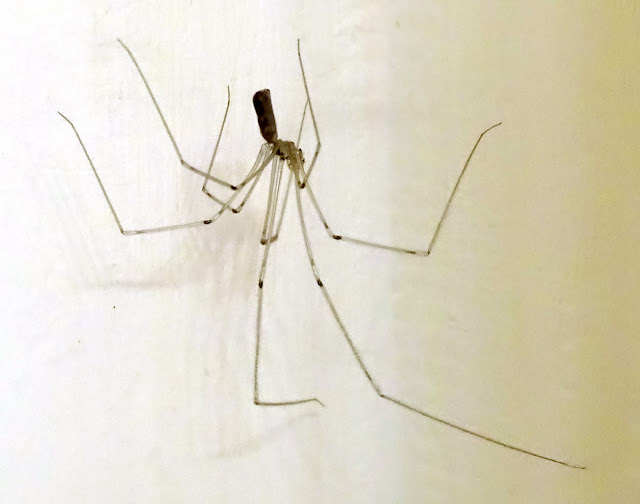Spider origins go far back in the web of life. Physical clues to their development and relationships are traced in specimens preserved for hundreds of millions of years in ancient amber, as well as by the very latest genome sequencing. This is the domain of arachnologists, spider experts, who extend the 'family tree' to bring all arachnids under the tent.
Arachnids are arthropods (invertebrate animals with an exoskeleton, a segmented body, and paired jointed appendages) with eight legs.
A startlingly close relative of arachnids is the horseshoe crab, which swims in the waters around Halibut Point. It has many more biological similarities to spiders than insects do, which are also arthropods but generally have six legs and two pairs of wings. Further away in construction, and closer to insects, are the crustaceous lobsters.
 |
Orchard Spider |
Spiders have a distinct abdomen that is separated from their singular
head-thoracic region (cephalothorax) by a constriction, and they usually have four
pairs of eyes.
Like most arachnids, spiders lack extensor muscles in the distal (further) joints of their appendages. They extend their limbs hydraulically by applying pressure to bodily fluids. This even accounts for the remarkable leaping ability of jumping spiders.
 |
| An Opiolione (Harvestman) |
Harvestmen, although similar in appearance to spiders, proceeded along a different evolutionary plan. They are distinguished by their fused body regions and single pair of eyes in the middle of their cephalothorax.
Another distinction is that some harvestmen extend their knees by the use of highly elastic thickenings in the joint cuticle, while others have evolved muscles that extend two leg joints (the femur-patella and patella-tibia joints) at once.
To see them glide like a gondola suspended from, and
directing, those inquisitive legs is to enjoy one of nature's exquisite
ballets.
 |
| Daddy Longlegs (true spider) in my bathroom |
Harvestmen look
superficially like the companionable Daddy Longlegs, which features a two-segmented
body, cylindrical abdomen, and eight eyes of a
true spider.
Within the arachnids, two broad groups of mites are represented at Halibut Point.
 |
A Velvet Mite, an arachnid, beside a blade of grass |
Velvet mites represent the Arcariforme group of
soft-bodied mites that ingest solid food such as fungi, algae, and soft-bodied
invertebrates.
 |
A Dog Tick, an
arachnid |
Dog ticks are a common example of the Parasitiformes which derive nutrients at the expense of other organisms without directly killing or ingesting them.
Crustaceans
making up a prominent group of non-arachnid arthropods are found both on land
and in the sea. They are distinguished by limbs that branch into two, each
branch developing a series of segments attached end-to-end.
 |
Woodlouse, a
crustacean |
Despite their unpleasant common name 'woodlice' fascinate children and make easy-care terrarium (or Dixie cup) pets where they inspire affectionate names such as roly-poly or pill bug.
In the final notable group of Arthropods at Halibut Point are
the terrestrial Myriapods characterized by numerous body segments, each
of which bears one or two pairs of seven-segmented walking legs.
.JPG) |
Centipede, a myriapod |
,%20Family%20Polydesmidae,Genus%20Polydesmus%20.JPG) |
Millipede, a myriapod |
Exploring
the intricacies of natural history, to the level of your interest, makes for
interesting reading in the era of Wikipedia
and online journal articles.

So interesting with a close-up, when we pay attention.
ReplyDelete